Is it time to stop growing pumpkins?
Grown, carved up, discarded. Food waste on a giant scale. Pumpkins v winter squash.

Driving through farmland one November, I looked to my right, to see a field scattered with splodges of bright orange. ‘Pumpkins’ my host said. ‘The fields are littered with them, all the ones they can’t sell.’
How many vegetables are grown just to be carved up and then discarded? Just the one that I can think of.
For twenty years, every October, I wrote a piece about pumpkins and winter squash, pleading with people to eat the pumpkins they’d be buying to carve up for Halloween. Every year, field upon field of unsold pumpkins collapse to compost in fields, those that aren’t sold cheaply by supermarkets. Most carved up specimens die on front doorsteps and in back gardens.
We grew up with the word ‘pumpkin’ rather than ‘winter squash’, just as all wild mushrooms were toadstools.
As far back as 1797, Mother Goose gave us;
Peter, Peter pumpkin eater,
Had a wife and couldn’t keep her,
Put her in a pumpkin shell,
And there he kept her very well.
There are plenty of competitions encouraging children to grow a giant pumpkin, and pick your own farms strewn with pumpkin patches, wheelbarrows at the ready.
Factor in;
The cost of buying the seeds
Nurturing and growing the seedlings
Planting them out
Watering, feeding and looking after them
Harvesting and storing them
Supermarkets setting the price for farmers
Selling them to customers who will carve them up, then throw them away.
Any that are unsold after 31st October are useless. Who wants to carve a pumpkin after Halloween? Unsold pumpkins might be fed to livestock but not all of them end up as treats for farm animals.
If a food writer specifies ‘pumpkin’ in a recipe and doesn’t explain what they mean, it’s possible that a well meaning reader will use a field pumpkin for their recipe and likely be very disappointed with the results.
Why grow something that’s inherently tasteless and watery? The field pumpkin is purportedly the best for carving but before pumpkins, we carved up swedes (turnips or neeps if you’re from the north of England, rutabaga if you’re in the US).
World record breaking pumpkin grower and RHS fruit and vegetable expert, Matthew Oliver quotes the adage that
‘A pumpkin is round and orange, a squash is good for eating.’
What’s in a name? Squash, pumpkin, or gourd, depending upon species and local parlance. It’s confusing. Some cultures, and many people call all winter squash pumpkins, whatever the variety. In the well known classic French version of Cinderella, written by Charles Perrault in 1697, he added extras to his story; glass slippers, a fairy godmother, and the pumpkin.
What variety inspired Perrault? Given that squash originated in Mexico and Central America around 8,000 – 10,000 years ago but were unknown in Europe until the late 16th century, he may have chosen it for the novelty factor. Apart from the appeal of the size and shape, a good fairy godmother could turn any vegetable into a carriage. Looking into Perrault’s history (you can thank me later), the childrens literature podcast states that the story was;
‘strikingly modern, from its use of the pumpkin, a new world plant, to its Enlightenment values celebrating Cinderella’s personal virtues even more highly than her beauty.’
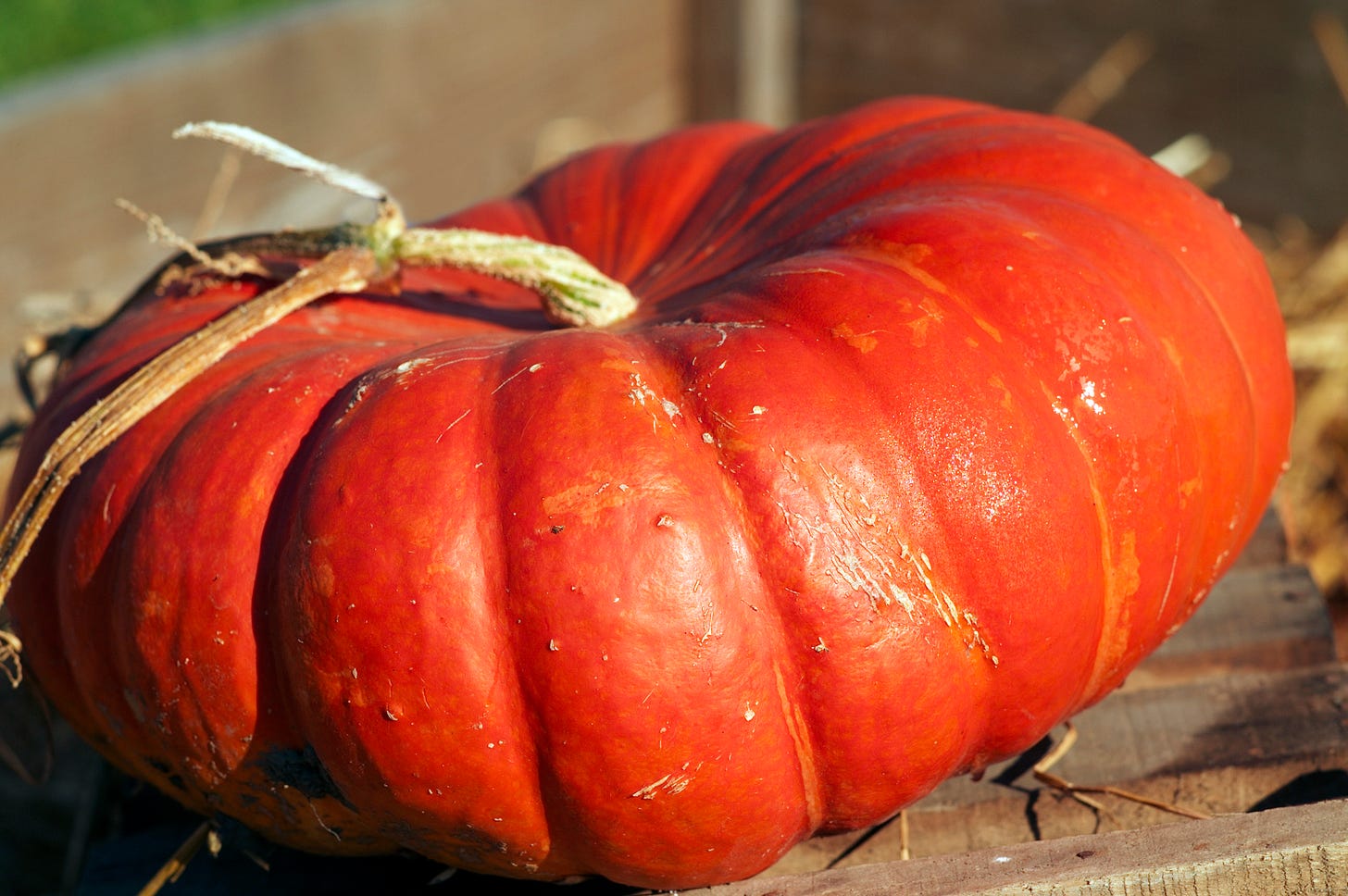
French variety Rouge d’Etampes was supposed to inspire the Disney artists when they were creating their version of Cinderella. In French it’s become more common for the word “citrouille” (pumpkin) to replace “potiron” (winter squash) because of the repeated influence of English during Halloween and in Disney films (where Cinderella’s carriage turns into a pumpkin, not a winter squash).
All winter squash, gourds and pumpkins come from the family Cucurbitaceae, also known as cucurbits or cucurbi. Latin for gourd, Cucurbits divide into five subspecies Cucurbita ficifolia (Malabar gourd), Cucurbita maxima, (autumn and winter squashes such as Hubbard, Red Kuri, Turban, Buttercup, Kabocha, Banana Squash and the giant pumpkin), Cucurbita mixta (Cushaw squash), Cucurbita moschata (Butternut, Honeynut, Musquee de Provence, and Black Futsu) and Cucurbita pepo (Acorn, Spaghetti, Delicata, Field Pumpkins and Decorative Gourds).
Melons, chayote and cucumbers are close relations. Altogether, the extended family numbers around 975 species.
The only cucurbit native to Britain is white bryony, a climbing vine.
Here's food writer Nigel Slater at the Royal Horticultural Society, checking out the 47 different cultivars of winter squash being trialled.
‘The word "squash" is an English corruption of the Narragansett word "askutasquash" meaning "a green thing eaten raw." The Abenaki (from North Eastern North America) word for pumpkin or squash is “wasawa”. The word squash was first recorded in English in 1640.’
‘The name pumpkin comes from the Greek word “pepon” which means “large melon”. The French turned it into “pompon” and the English changed it to “pumpion”. The name “pumpkin” was used by American colonists.’
More here, courtesy of Border Crossings which celebrates the worlds first nations.
Many cultures revere the squash family. In China, a gould that is shaped like an hourglass, is named for Li T’ieh-kuai, one of the 8 immortals, symbolising the two opposites; night and day, good and evil.
I realise that I’m in danger of falling down rabbit holes as long as the average cucurbit vine so let’s move on.
It’s controversial to ask you to try to get out of the habit of using the word pumpkin for all winter squash. Many chefs and food writers use both words interchangeably. My inbox is full of posts about pumpkins. I’m asking for the simple reason that a field pumpkin, the run of the mill Halloween pumpkin for the most part isn’t worth eating, and the rest of the bunch, all the amazing winter squash varieties, are. If a food writer specifies ‘pumpkin’ in a recipe and doesn’t explain what they mean, it’s possible that a well meaning reader will use a field pumpkin for their recipe and likely be very disappointed with the results. I am asking that if you buy a pumpkin, you eat it, but at least be aware of the differences. And if you have a choice, pick a winter squash over a pumpkin.
Saying ‘pumpkin’ is easier and less clunky than the three syllable ‘winter squash’ but we manage, when talking about citrus fruits to pronounce ‘clementine’ or ‘satsuma’ without undue effort. However, the seeds of the winter squash are always ‘pumpkin seeds’, the oil is always pumpkin oil, and I imagine they’ll remain so.

All winter squashes are harvested in September and October, but only Cucurbita pepo species go straight to market. The other varieties are left to cure for a few weeks to harden the skins. I've harvested and cured winter squash in October, and stored them until the following February.
Pumpkins may in theory be edible, but the larger they are, the more watery and tasteless they become. There are exceptions; scroll down this excellent list of varieties to see what Real Seeds say about the pumpkin seeds they sell. Farmers I’ve spoken to say they’d not grow anything that didn’t taste good.
THIS is a great learning resource about winter squash and pumpkins.
As I was writing this post, an email arrived from Little Portland Cooking School with this recipe.
Each year, thousands of acres of farmland are used to grow Halloween pumpkins only to have tons of carved pumpkins sent to the landfill once the festivities are over. Not only is this a waste of a valuable, nutritious food — it’s also a waste of your money. And the waste doesn’t end there; if you buy costumes for Halloween do read this first in a report that found 83% of Halloween costumes used non-recyclable oil-based plastics which meant they were destined to end up in landfill.
In Lincolnshire, Bells Pumpkin Patch harvest around 2 million pumpkins, and have a giant pumpkin cannon. Yes you read that right. Not only do they grow pumpkins, you can fire one out of a cannon too. And they’re not the only ones. There are farms all over the US and in the UK that have cannons. Here in the UK they’re part of the ‘rural business’ diversification’ which to me means that farms stop farming and start becoming theme parks.
According to Waste Managed, 40% of UK consumers buy pumpkins to carve for Halloween, but 60% report that they don’t use the pumpkin to make any food such as pumpkin soup and instead just throw it into the general waste bin after they’ve finished carving. The article continues to say;
‘'A colossal 18,000 tonnes of pumpkins are thrown away each year which is about 360 million portions of pumpkin pie!’’
That’s a frightful 12.8 million pumpkins in the UK, likely to be discarded, say Love Food, Hate Waste
But the wasted potential for food is not the scariest thing about pumpkin waste.
When pumpkins are sent to landfill, they decompose and produce methane.
The Sustainable Food Trust quotes charity Hubbub’s figures; in 2022, of the estimated 39.9 million pumpkins that were bought, 22.2 million were likely to go to waste.
The money lost due to pumpkin waste is also staggeringly high, at an alarming £32.6 million.
Hubbub have a useful free booklet full of pumpkin recipes although personally, I think pumpkin pie needs a really dry squash puree and pumpkin is often far too wet. Whilst writing this, I came across one of
s brilliant dives into ingredients. Here's her take on the best squash for cooking.National Geographic contributes an article on ideas for keeping pumpkins out of land fill.
If you’re not going to eat it, don’t buy one. Supermarkets could do far more to spread the word that the pumpkins they sell are edible. According to Tesco, last year the number of their customers searching for pumpkin recipes online increased tenfold.
It’s reassuring talking to Martin Fermor from Perry Court Farm in Kent, that his customers are asking the right questions and know what to look for; a squash that will carve and be good to eat.
Countryside Online has a thoughtful article on pumpkin farms looking at what happens to any that are unsold and how to make the most of your pumpkin including a plea to buy direct from farms and farmers markets.
If you’re going to buy one, choose a small pumpkin, it will have more flavour. Cook it all; skin, flesh and seeds. Even better, choose a winter squash, direct from a farm or farmers market. Many years ago I was given a cute little book; Play with your Pumpkins (Joost Elffers & Saxton Freymann) with stunning photos of pumpkin carving that encourages readers to use the stem as the nose and not throw out its guts, so to speak.
Another Substack missive that arrived whilst I was writing this, from
also full of useful winter squash recipe links.Every bit can be eaten; skin, flesh and seeds. Spread the word; #Eatyourpumpkin
Thank you for following and subscribing, it’s wonderful to have you here. My posts are currently all free. However, words and food are two of the hardest fields to make a living in, so if you like what you read or find my work helpful, please consider pledging or upgrading to a paid subscription. Many thanks.



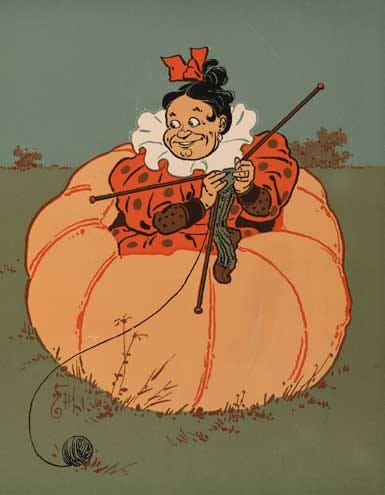


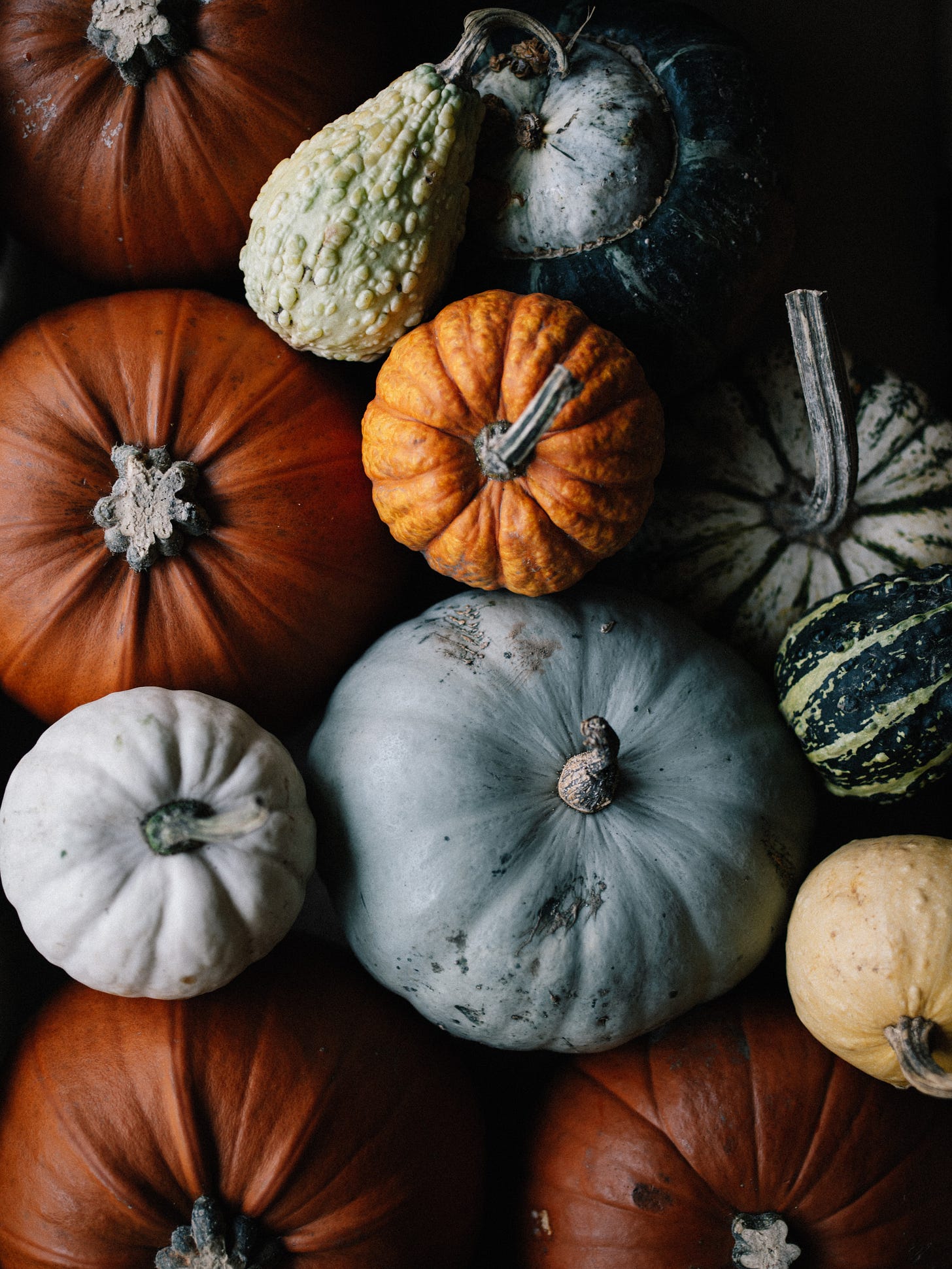
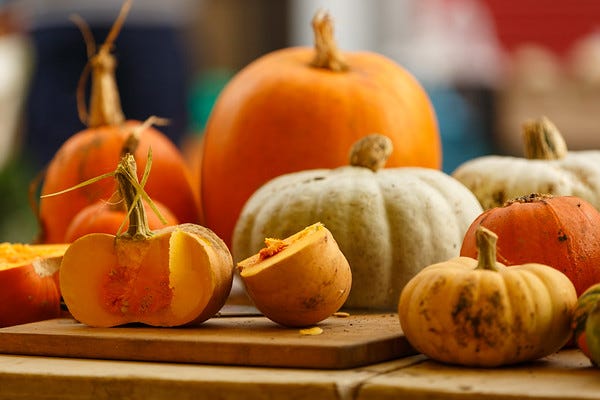
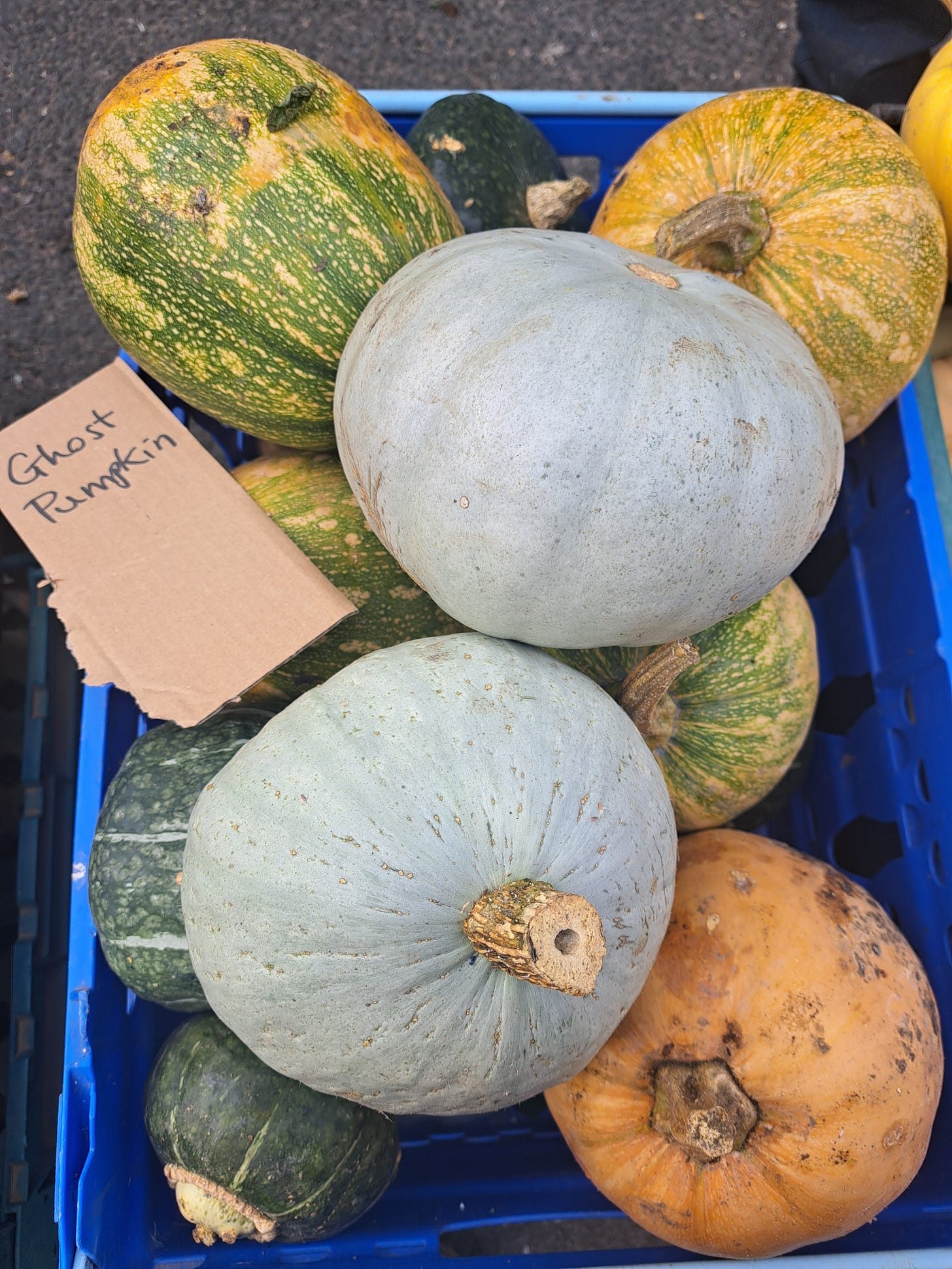


So much waste, some people have probably been carving for years and never tasted the Pumpkin. Or Winter Squash, or……
What’s also sad is when supermarkets label some squash as ‘culinary’ squash to get over the fact that they are edible and not just for decoration or carving. One I bought and cooked recently tasted wonderful with a lovely chestnut flavour.